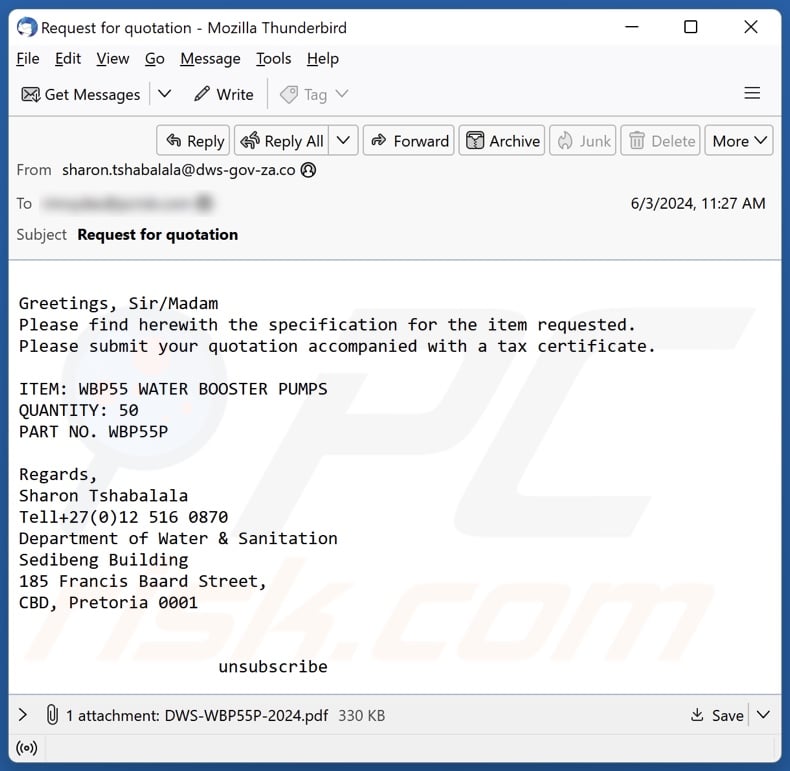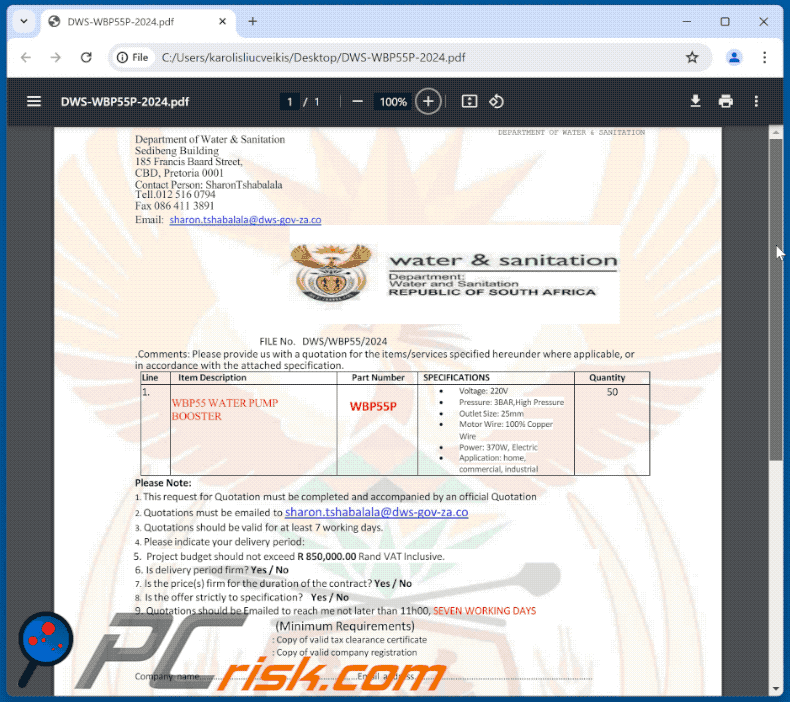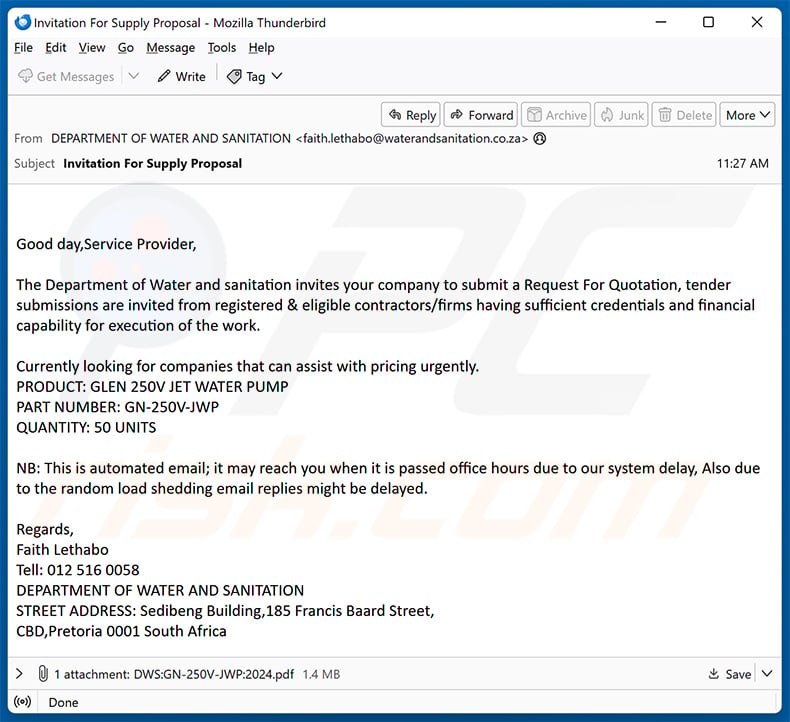Avoid getting scammed by fake "Specification For The Item Requested" email
Phishing/ScamAlso Known As: "Specification For The Item Requested" phishing email
Get free scan and check if your device is infected.
Remove it nowTo use full-featured product, you have to purchase a license for Combo Cleaner. Seven days free trial available. Combo Cleaner is owned and operated by RCS LT, the parent company of PCRisk.com.
What kind of email is "Specification For The Item Requested"?
Upon inspection of the "Specification For The Item Requested" email, we determined that it is spam. This letter is presented as a quote request for specified items. The phishing mail targets the recipient's company data.
However, the goal of this campaign may be to entangle victims in a complex scheme wherein they are deceived into revealing confidential data, sending money to scammers, or infecting their networks with malware.

"Specification For The Item Requested" email scam overview
The email with the subject "Request for quotation" (may vary) is presented as a request for a quotation. The details for the items sought by the sender can be found in the attachment.
It must be emphasized that the information provided in this email and the attached file is false, and this mail is not associated with any legitimate entities.
The attachment – "DWS-WBP55P-2024.pdf" (filename may vary) – asks the recipient to provide their company's name, registration number, tax certificate, and contact person's details (including email and telephone number).
However, this phishing mail may have other aims as well. If victims are lured into communicating with scammers, they can be deceived into carrying out various actions. For example, cyber criminals may request users to open virulent files and infect their systems (that may be connected to the company network).
Alternatively, an infection can originate from a malicious website that either infiltrates malware onto devices or tricks visitors into downloading/installing it themselves. The proliferated malicious software can be a trojan, ransomware, cryptocurrency miner, and so on.
Scammers can ask for confidential, compromising, or other incredibly sensitive information. They may obtain it by having the victims disclose it directly or through phishing files/sites that record entered data. By acquiring the log-in credentials of emails, social networking, messengers, or similar accounts – criminals can request the contacts/friends/followers for loans or donations, promote scams, and proliferate malware.
Stolen finance-related accounts, such as online banking, e-commerce, money transferring, digital wallets, etc. – can be used to make fraudulent transactions and online purchases. Additionally, sensitive data can be used for blackmail, held for ransom, or otherwise abused for profit.
Cyber criminals can ask for bogus payments (e.g., taxes, bills, fees, etc.). Difficult-to-trace methods are used to acquire funds, such as cryptocurrencies, pre-paid vouchers, gift cards, cash hidden in innocent-looking packages and shipped, etc. Relying on these methods diminishes the chances of prosecution for criminals and money retrieval for victims.
To summarize, by trusting an email like "Specification For The Item Requested" – users can experience system infections, severe privacy issues, financial losses, and even identity theft.
If you have disclosed personally identifiable or finance-related information (e.g., ID card details, passport scans/photos, banking account data, credit card numbers, etc.) – immediately contact the appropriate authorities.
However, if you have provided your log-in credentials – change the passwords of all possibly compromised accounts and inform their official support without delay.
If you suspect that your device has been infected – perform a complete system scan with an anti-virus and eliminate all detected threats.
| Name | "Specification For The Item Requested" phishing email |
| Threat Type | Phishing, Scam, Social Engineering, Fraud |
| Fake Claim | Email requests to provide a quotation and disclose company details. |
| Attachment(s) | DWS-WBP55P-2024.pdf (filename may vary) |
| Detection Names (attachment) | N/A (VirusTotal) |
| Symptoms | Unauthorized online purchases, changed online account passwords, identity theft, illegal access of the computer. |
| Distribution methods | Deceptive emails, rogue online pop-up ads, search engine poisoning techniques, misspelled domains. |
| Damage | Loss of sensitive private information, monetary loss, identity theft. |
| Malware Removal (Windows) |
To eliminate possible malware infections, scan your computer with legitimate antivirus software. Our security researchers recommend using Combo Cleaner. Download Combo CleanerTo use full-featured product, you have to purchase a license for Combo Cleaner. 7 days free trial available. Combo Cleaner is owned and operated by RCS LT, the parent company of PCRisk.com. |
Spam campaigns in general
We have analyzed countless spam emails; "Subscribed Domain Used For Spamming Purposes", "T-Mobile Network Global Funds Relief", "SKY LOTTO", "Remittance Note", "You Were Scammed A Huge Sum Of Money", "Products We Want To Purchase", "Commercial Invoice", "PayPal Escrow Account", and "Interpol email virus" are just some of our newest finds.
Spam mail is used to facilitate a wide variety of scams, including (but not limited to) phishing, financial fraud, inheritance, lottery, refund, sextortion, tech support, and so forth. Furthermore, these letters can proliferate malware.
While scam mail can rely on different disguises and mechanisms, its end goal is the same – to generate revenue at victims' expense.
Spam emails can be shoddily put together and riddled with errors, or they can be competently crafted and even believably disguised as messages from legitimate entities (e.g., companies, corporations, institutions, organizations, service providers, authorities, etc.).
How do spam campaigns infect computers?
Cyber criminals commonly use spam campaigns to distribute malware. Deceptive emails/messages can have malicious files attached to or linked inside them. Infectious files come in various formats, e.g., executables (.exe, .run, etc.), archives (RAR, ZIP, etc.), documents (Microsoft Office, Microsoft OneNote, PDF, etc.), JavaScript, and so on.
The malware download/installation chain is initiated once a virulent file is opened. Some formats require additional user interaction to jumpstart these processes. For example, Microsoft Office files need users to enable macro commands (i.e., editing/content), while OneNote documents require them to click on embedded links or files.
How to avoid installation of malware?
Incoming emails, DMs/PMs, SMSes, and other messages must be treated with caution. Do not open attachments or links found in suspicious/irrelevant mail, as they can be harmful or infectious. However, malware is not proliferated exclusively via spam mail.
Therefore, be vigilant while browsing since fraudulent and malicious online content typically appears genuine and harmless.
Additionally, download only from official and trustworthy channels. Activate and update software using functions/tools provided by legitimate developers, as illegal activation ("cracking") tools and third-party updaters may contain malware.
It is paramount for device integrity and user safety to have a reputable anti-virus installed and kept up-to-date. Security programs must be used to run regular system scans and to remove detected threats/issues. If you've already opened malicious attachments, we recommend running a scan with Combo Cleaner Antivirus for Windows to automatically eliminate infiltrated malware.
Text presented in the "Specification For The Item Requested" spam email letter:
Subject: Request for quotation
Greetings, Sir/Madam
Please find herewith the specification for the item requested.
Please submit your quotation accompanied with a tax certificate.
ITEM: WBP55 WATER BOOSTER PUMPS
QUANTITY: 50
PART NO. WBP55P
Regards,
Sharon Tshabalala
Tell+27(0)12 516 0870
Department of Water & Sanitation
Sedibeng Building
185 Francis Baard Street,
CBD, Pretoria 0001
Appearance of the file attached to this spam email ("DWS-WBP55P-2024.pdf") GIF:

Another example of an email from "Specification For The Item Requested" spam campaign:

Text presented within:
Subject: Invitation For Supply Proposal
Good day,Service Provider,
The Department of Water and sanitation invites your company to submit a Request For Quotation, tender submissions are invited from registered & eligible contractors/firms having sufficient credentials and financial capability for execution of the work.
Currently looking for companies that can assist with pricing urgently.
PRODUCT: GLEN 250V JET WATER PUMP
PART NUMBER: GN-250V-JWP
QUANTITY: 50 UNITSNB: This is automated email; it may reach you when it is passed office hours due to our system delay, Also due to the random load shedding email replies might be delayed.
Regards,
Faith Lethabo
Tell: 012 516 0058
DEPARTMENT OF WATER AND SANITATION
STREET ADDRESS: Sedibeng Building,185 Francis Baard Street,
CBD,Pretoria 0001 South Africa
Instant automatic malware removal:
Manual threat removal might be a lengthy and complicated process that requires advanced IT skills. Combo Cleaner is a professional automatic malware removal tool that is recommended to get rid of malware. Download it by clicking the button below:
DOWNLOAD Combo CleanerBy downloading any software listed on this website you agree to our Privacy Policy and Terms of Use. To use full-featured product, you have to purchase a license for Combo Cleaner. 7 days free trial available. Combo Cleaner is owned and operated by RCS LT, the parent company of PCRisk.com.
Quick menu:
- What is "Specification For The Item Requested" phishing email?
- Types of malicious emails.
- How to spot a malicious email?
- What to do if you fell for an email scam?
Types of malicious emails:
![]() Phishing Emails
Phishing Emails
Most commonly, cybercriminals use deceptive emails to trick Internet users into giving away their sensitive private information, for example, login information for various online services, email accounts, or online banking information.
Such attacks are called phishing. In a phishing attack, cybercriminals usually send an email message with some popular service logo (for example, Microsoft, DHL, Amazon, Netflix), create urgency (wrong shipping address, expired password, etc.), and place a link which they hope their potential victims will click on.
After clicking the link presented in such email message, victims are redirected to a fake website that looks identical or extremely similar to the original one. Victims are then asked to enter their password, credit card details, or some other information that gets stolen by cybercriminals.
![]() Emails with Malicious Attachments
Emails with Malicious Attachments
Another popular attack vector is email spam with malicious attachments that infect users' computers with malware. Malicious attachments usually carry trojans that are capable of stealing passwords, banking information, and other sensitive information.
In such attacks, cybercriminals' main goal is to trick their potential victims into opening an infected email attachment. To achieve this goal, email messages usually talk about recently received invoices, faxes, or voice messages.
If a potential victim falls for the lure and opens the attachment, their computers get infected, and cybercriminals can collect a lot of sensitive information.
While it's a more complicated method to steal personal information (spam filters and antivirus programs usually detect such attempts), if successful, cybercriminals can get a much wider array of data and can collect information for a long period of time.
![]() Sextortion Emails
Sextortion Emails
This is a type of phishing. In this case, users receive an email claiming that a cybercriminal could access the webcam of the potential victim and has a video recording of one's masturbation.
To get rid of the video, victims are asked to pay a ransom (usually using Bitcoin or another cryptocurrency). Nevertheless, all of these claims are false - users who receive such emails should ignore and delete them.
How to spot a malicious email?
While cyber criminals try to make their lure emails look trustworthy, here are some things that you should look for when trying to spot a phishing email:
- Check the sender's ("from") email address: Hover your mouse over the "from" address and check if it's legitimate. For example, if you received an email from Microsoft, be sure to check if the email address is @microsoft.com and not something suspicious like @m1crosoft.com, @microsfot.com, @account-security-noreply.com, etc.
- Check for generic greetings: If the greeting in the email is "Dear user", "Dear @youremail.com", "Dear valued customer", this should raise suspiciousness. Most commonly, companies call you by your name. Lack of this information could signal a phishing attempt.
- Check the links in the email: Hover your mouse over the link presented in the email, if the link that appears seems suspicious, don't click it. For example, if you received an email from Microsoft and the link in the email shows that it will go to firebasestorage.googleapis.com/v0... you shouldn't trust it. It's best not to click any links in the emails but to visit the company website that sent you the email in the first place.
- Don't blindly trust email attachments: Most commonly, legitimate companies will ask you to log in to their website and to view any documents there; if you received an email with an attachment, it's a good idea to scan it with an antivirus application. Infected email attachments are a common attack vector used by cybercriminals.
To minimise the risk of opening phishing and malicious emails we recommend using Combo Cleaner Antivirus for Windows.
Example of a spam email:

What to do if you fell for an email scam?
- If you clicked on a link in a phishing email and entered your password - be sure to change your password as soon as possible. Usually, cybercriminals collect stolen credentials and then sell them to other groups that use them for malicious purposes. If you change your password in a timely manner, there's a chance that criminals won't have enough time to do any damage.
- If you entered your credit card information - contact your bank as soon as possible and explain the situation. There's a good chance that you will need to cancel your compromised credit card and get a new one.
- If you see any signs of identity theft - you should immediately contact the Federal Trade Commission. This institution will collect information about your situation and create a personal recovery plan.
- If you opened a malicious attachment - your computer is probably infected, you should scan it with a reputable antivirus application. For this purpose, we recommend using Combo Cleaner Antivirus for Windows.
- Help other Internet users - report phishing emails to Anti-Phishing Working Group, FBI’s Internet Crime Complaint Center, National Fraud Information Center and U.S. Department of Justice.
Frequently Asked Questions (FAQ)
Why did I receive this email?
Regardless of any relevant details that they may include, spam emails are not personal. This information (if present) is likely acquired through publicly available sources. Spam mail is distributed in large-scale operations – hence, thousands of users receive identical (or incredibly similar) emails.
I have provided my personal information when tricked by this spam email, what should I do?
If you have provided your log-in credentials – change the passwords of all possibly exposed accounts and inform their official support. And if you've disclosed other private information (e.g., passport photos/scans, ID card details, credit card numbers, etc.) – contact relevant authorities without delay.
I have read a spam email but didn't open the attachment, is my computer infected?
Devices are infected when malicious attachments or links are opened/clicked; merely reading an email does not pose an infection threat.
I have downloaded and opened a file attached to a spam email, is my computer infected?
That depends on the purpose of the attached file (e.g., decoy, phishing, malware download/installation, etc.). Executables (.exe, .run, etc.) cause infections almost without fail once opened. Some formats like virulent documents (.doc, .xls, .one, .pdf, etc.) may need additional user interaction to trigger infection processes (e.g., enabling macro commands, clicking embedded content, etc.).
Will Combo Cleaner remove malware infections present in email attachments?
Yes, Combo Cleaner is capable of detecting and eliminating nearly all known malware infections. It must be stressed that since sophisticated malicious programs typically hide deep within systems – running a full system scan is crucial.
Share:

Tomas Meskauskas
Expert security researcher, professional malware analyst
I am passionate about computer security and technology. I have an experience of over 10 years working in various companies related to computer technical issue solving and Internet security. I have been working as an author and editor for pcrisk.com since 2010. Follow me on Twitter and LinkedIn to stay informed about the latest online security threats.
PCrisk security portal is brought by a company RCS LT.
Joined forces of security researchers help educate computer users about the latest online security threats. More information about the company RCS LT.
Our malware removal guides are free. However, if you want to support us you can send us a donation.
DonatePCrisk security portal is brought by a company RCS LT.
Joined forces of security researchers help educate computer users about the latest online security threats. More information about the company RCS LT.
Our malware removal guides are free. However, if you want to support us you can send us a donation.
Donate
▼ Show Discussion